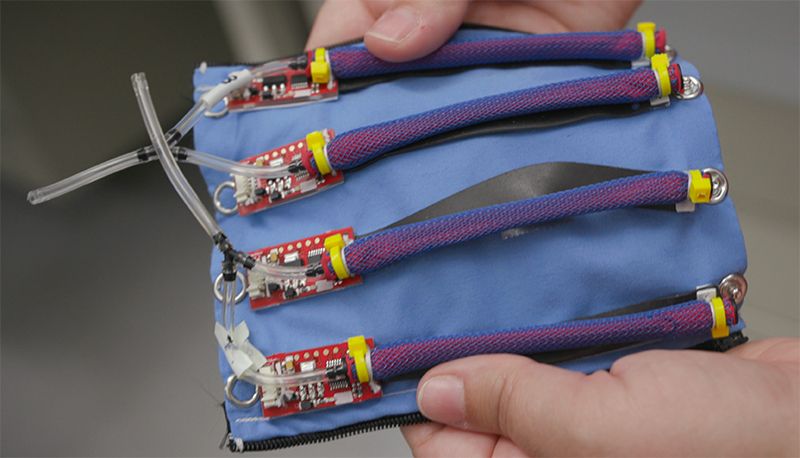These “Robotic Skins” Turn Everyday Objects Into Robots
A team at Yale University has developed flexible robotic sheets that can make just about anything move
/https://tf-cmsv2-smithsonianmag-media.s3.amazonaws.com/filer/d0/d6/d0d69ac4-27cb-4097-baa5-140148bd6505/robotic-skins.jpg)
What if there was some kind of flexible, stretchy material that you could wrap around just about any random object and turn it into a robot? It sounds like a gadget that might belong to a superhero, but a team of researchers has developed just that.
They call it OmniSkins, in a paper published today in Science Robotics. It’s made of a combination of elastic materials (or fabric, in one version) embedded with sensors and actuators that when stuck to, wrapped around, or layered can make just about any inanimate object move. The team, led by roboticist Rebecca Kramer-Bottiglio of Yale University, was able to apply the so-called skins to a broad range of stuff, from foam pool noodles to T-shirts, even icosahedrons, or geometric figures with 20 triangular faces.
“The reconfigurable and re-programmable nature of the soft robotic skins is very cool,” says Conor Walsh, a roboticist from Harvard University who was not involved in the study. “The idea that we can have a soft and flexible sheet, wrap it around any surface, have it learn what it is attached to and then move it in some desired way has a lot of potential.”
Kramer-Bottiglio got the idea for OmniSkins when she was working on a solicitation from NASA to create soft robotics that could be useful in space. When sending robots into space, you have to try to make them as small and light as possible, which got Kramer-Bottiglio to thinking, what if we could reduce the number of robots altogether and instead send just a few robots that could be reconfigured to do different tasks? That’s when she thought to create lightweight robotic skins that can be stored flat during transport and repurposed over and over again.
“They can be applied to, removed from, and transferred between various host objects, so we can use the same hardware over and over again to generate many different configurations with many different functions,” Kramer-Bottiglio points out. “The robotic skins are modular, like Legos. They can be combined, separated, and re-combined in different patterns.”
The main caveat is that they should be stuck to an object that is flexible. “If you wrap the robotic skins around an object that is too stiff, nothing will move. We recommend that users just try different combinations and see what happens," she says.
The team tried the skins on several objects for size. In one design, they wrapped a small foam cylinder, making it move like an inchworm, and added a camera to the end of it. In another, they programmed the inchworm to sense light and crawl toward it. “That's the true spirit of this work,” she says. “Design on the fly.”

“Additional hardware, such as environmental sensors and cameras, can easily be added,” says Kramer-Bottiglio. “Future astronauts exploring another planet could quickly construct a robot using the robotic skins wrapped around whatever deformable materials they have access to and stick a camera on it, and then deploy the robot for exploration of small or dangerous spaces.”
Something like the OmniSkin icosahedron could also have applications in space. For one, it’s really easy to construct quickly. The team’s new device was actually inspired by a robotic lander NASA already uses called the Super Ball Bot, which is composed of what’s called a tensegrity structure, or a three-dimensional shape of bars and cables that can absorb shock and compression. In this exercise, they put triangular skins on each of its 20 faces, which allowed them to make a previously inanimate geometric object roll around.
The applications in space are countless, but the researchers had some fun exploring other uses. They stuck six triangles on the back of T-shirt and programmed it to nudge the user when he displayed poor posture. They also fastened three foam arms together and made it move like one of those arcade claw machine games—theirs will actually grip the object and retrieve it, of course. In one of the demonstrations the team uses to introduce people to OmniSkins, they wrap a skin around each of the four legs of a stuffed animal horse—kind of like pants—and make it walk.
“I'm really excited to see what other people will do with robotic skins,” says Kramer-Bottiglio. “The possibilities are endless.”
/https://tf-cmsv2-smithsonianmag-media.s3.amazonaws.com/accounts/headshot/rachael.png)


/https://tf-cmsv2-smithsonianmag-media.s3.amazonaws.com/accounts/headshot/rachael.png)